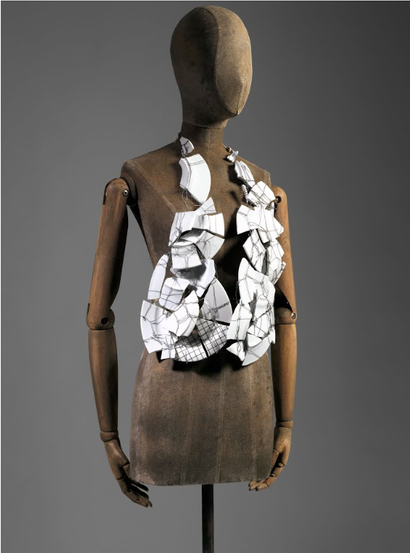FC316 - Week 15 - Research and Analysis.
- yatian Qian
- Feb 15, 2023
- 3 min read
Updated: Feb 16, 2023
I would like to focus on Maison Margiela's work waistcoat this week.
Image 1. Left Image: Waistcoat by Maison Margiela. (1989). Porcelain, metal, cotton, French.
Image 2. Right Image: Vest by Maison Margiela. (1989). Porcelain, metal, cotton, French.
It's a garment from Maison Margiela 1989–90 fall/winter runway. It is made of porcelain, metal and cotton. Margiela tied broken pieces of porcelain with metal wires and connected it with a cotton band to form a "U" shape vest.
In my opinion, this work is very unusual for me as a garment. We could hardly see designer using porcelain and metal as mediums to make a garment. Also, the shape this work which looks like a "U" are hardly see in the design of vest.
I think Margiela picked these colors, which was mainly white, grey and a little bit of blue, because he wanted the audience to focus more on the structure and materials of this object.
Margiela didn't mention the meaning or inspiration of this work. In fact, he was known for refusing to participate in interviews and portraits, he was mainly focus on his design outputs. (The Metropolitan Museum of Art, N.d.)
I would like to talk about my opinion on this work in terms of meanings and inspirations. Firstly, compare to the general garments which was made to covering our body and be soft and warm, this work didn't show any similarities. This work, especially the porcelain part, is hard, sharp, and not suitable to wear. I would like to treat this work more like a sculpture rather than a garment. His introduction of porcelain and metal to the garment-making is an attempt to exploring the boundary of fashion design materials. This attempt reminds me of the fountain by Duchamp, he was also exploring the boundary of art and sculpture by introducing ready-made objects to the art and sculpture field.

Image 3 Fountain by Marcel Duchamp, 1917.
A urinal was purchased by Duchamp from a sanitary ware supplier and submitted as an artwork by 'R Mutt' to the newly founded Society of Independent Artists, which he had helped found and promote. The society’s board of directors, who are bound by the society’s constitution to accept all members’ submissions, took exception with Fountain, believing that sanitary ware – one associated with bodily waste – cannot be considered a work of art and furthermore was indecent. It was narrowly decided by the directors present during the installation of the exhibition at the Grand Central Palace that the submission would not be included in the Society's inaugural exhibition that opened to the public on 10 April 1917. Duchamp and Arensberg resigned after the board used its veto power to effectively censor an artist's work. (Tate, N.d.)
In his work, Duchamp attempted to subvert traditional notions of good taste. The artist argued that anything could qualify as art, no matter how good, bad or ugly, as long as it is selected and referred to as art by the artist. In doing so, Duchamp demonstrated that the concept behind an artwork was more important than the object itself, and this became a cornerstone of Conceptual Art.
In this case, I believe Margiela was also challenging the traditional opinions about garments and Fashion. Dose a garment have to be made by fabric? Does it have to be comfortable? If the garment was made by materials other than fabric, did it still could be seen as a garment? In this case, he was exploring the boundary of fashion and surely influenced the fashion industry.
I like this work because it made me think the possibilities of fashion and garments in terms of materials. I really get inspired from him and my fashion attitude expanded from creating beautiful garments and patterns to using garments as a medium to present my ideas and concepts.
Image Reference List
Image 1. Maison Margiela. (1989). Waistcoat. Available from: Maison Margiela | Waistcoat | French | The Metropolitan Museum of Art (metmuseum.org). [Accessed 17th February]
Image 2. Maison Margiela. (1989). Vest. Porcelain, metal, cotton, French. Available from: Maison Margiela | Vest | French | The Metropolitan Museum of Art (metmuseum.org). [Accessed 17th February]
Reference List
The Metropolitan Museum of Art. Waistcoat. (No date). Available from: Maison Margiela | Waistcoat | French | The Metropolitan Museum of Art (metmuseum.org). [Accessed 17th February]
Tate. Marcel Duchamp Fountain 1917, replica 1964. (No date). Available from: ‘Fountain‘, Marcel Duchamp, 1917, replica 1964 | Tate. [Accessed 17th February]
TheCollector. What Was So Great About Marcel Duchamp’s Fountain?. (No date). Available from: https://www.thecollector.com/what-was-great-about-marcel-duchamp-fountain/. [Accessed 17th February]
Thank you!







Comments